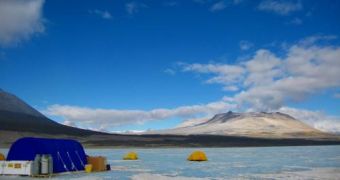Recent research on the Lake Vida, plunged for 2800 years under a 20-meter thick ice layer in the McMurdo Dry Valleys of East Antarctica, unveils difficult-to-explain bacterial life.
The community of bacteria lives in a completely sealed medium, with no oxygen, with salty water, negative temperatures that go down to -13 C, and an environment with the highest degree of nitrous oxide concentration ever known in the aquatic world, New Scientist reports.
“There are various lakes that are very salty down there... but this is a really freaky one,” said Cynan Ellis-Evans, a scientist from the British Antarctic Survey.
“It's almost frozen solid right to the bottom. But you've got this brine 'mush' in the center. For several years, they've been trying to get into it.”
Analyses have led to the supposition that bacteria life might be made possible due to the energy provided by molecular hydrogen produced as a consequence of certain chemical reactions occurring between the pickle and the iron-reach residuum underneath.
“It's plausible that a life-supporting energy source exists solely from the chemical reaction between anoxic salt water and the rock,” explained Dr. Christian Fritsen, co-author of the study.
The creatures living in such a harsh environment increases scientists' hope that life can be possible in extraterrestrial places such as Mars or Jupiter's Europa.
“Lake Vida is a model of what happens when you try to freeze a lake solid, and this is the same fate that any lakes on Mars would have gone through as the planet turned colder from a watery past,” declared Peter Doran, a researcher at the University of Illinois in Chicago.
“Any Martian water bodies that did form would have gone through this Vida stage before freezing solid, entombing the evidence of the past ecosystem,” he went on explaining.
The research is included in the “Microbial Life at -13ºC in the Brine of an Ice-Sealed Antarctic Lake” study, led by Nathaniel Ostrom from Michigan State University and published in the journal Proceedings of the National Academy of Sciences.

 14 DAY TRIAL //
14 DAY TRIAL //